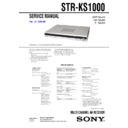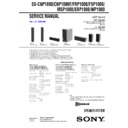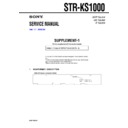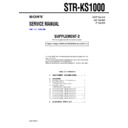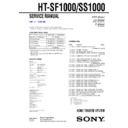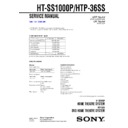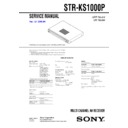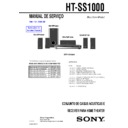Sony HT-SF1000 / HT-SS1000 / STR-KS1000 Service Manual ▷ View online
SERVICE MANUAL
MULTI CHANNEL AV RECEIVER
AEP Model
UK Model
E Model
STR-KS1000
•
STR-KS1000 is the receiver section in HT-SF1000/SS1000.
Ver. 1.2 2006.08
9-887-058-03
2006H05-1
© 2006.08
© 2006.08
Sony Corporation
Home Audio Division
Published by Sony Techno Create Corporation
Published by Sony Techno Create Corporation
This receiver incorporates Dolby* Digital and Pro
Logic Surround and the DTS** Digital Surround
System.
*
Logic Surround and the DTS** Digital Surround
System.
*
Manufactured under license from Dolby
Laboratories.
Laboratories.
“Dolby”, “Pro Logic” and the double-D symbol
are trademarks of Dolby Laboratories.
are trademarks of Dolby Laboratories.
**“DTS” and “DTS Digital Surround” are
registered trademarks of Digital Theater
Systems, Inc.
Systems, Inc.
– Continued on next page –
SPECIFICATIONS
Amplifier section
HT-SF1000 only
Power Output
1)
Stereo mode (rated) 70 W + 70 W
(4 ohms at 1 kHz, 0.7%)
Music power output (reference)
FRONT
2)
: 143 W/ch
(With SS-FSP1000)
CENTER
2)
: 143 W
(With SS-CNP1000F)
SUR
2)
: 143 W/ch
(With SS-FRP1000)
SUBWOOFER
2)
: 285 W
(With SS-WP1000)
HT-SS1000 only
Power Output
1)
Stereo mode (rated) 70 W + 70 W
(4 ohms at 1 kHz, 0.7%)
Music power output (reference)
FRONT
2)
: 143 W/ch
(With SS-MSP1000)
CENTER
2)
: 143 W
(With SS-CNP1000)
SUR
2)
: 143 W/ch
(With SS-SRP1000)
SUBWOOFER
2)
: 285 W
(With SS-WP1000)
1)
Measured under the following conditions:
2)
Depending on the sound field settings and the
source, there may be no sound output.
source, there may be no sound output.
Inputs (Analog)
Area code
Power requirements
CEL, CEK, SP, MY,
AR
230 V AC, 50 Hz
E51
240 V AC, 50 Hz
SA-CD/CD,
VIDEO 1, 2
Sensitivity: 1 V
Impedance: 50 kohms
Tone
FM tuner section
Tuning range
87.5 - 108.0 MHz
Antenna
FM wire antenna
Antenna terminals
75 ohms, unbalanced
Intermediate frequency
10.7 MHz
AM tuner section
Tuning range
Models of area code CEL, CEK SP, MY
,
With 9-kHz tuning scale:
531
−
1,602 kHz
Gain levels
±
6 dB, 1 dB step
Inputs (Digital)
Reproduction frequency range:
28
−
20,000 Hz
DVD (Coaxial)
Sensitivity:
−
Impedance: 75 ohms
VIDEO 2, SA-CD/
CD (Optical)
CD (Optical)
Sensitivity:
−
Impedance:
−
Models of area code E51
With 10-kHz tuning scale:
530
−
1,610 kHz
3)
With 9-kHz tuning scale:
531
−
1,602 kHz
3)
Models of area code AR
With 10-kHz tuning scale:
530
−
1,610 kHz
Antenna
Loop antenna
Intermediate frequency
450 kHz
3)
You can change the AM tuning scale to 9 kHz or
10 kHz. After tuning in any AM station, turn off
the receiver. While holding down PRESET
TUNING +, press ?/1. All preset stations will be
erased when you change the tuning scale. To reset
the scale to 10 kHz (or 9 kHz), repeat the
procedure.
10 kHz. After tuning in any AM station, turn off
the receiver. While holding down PRESET
TUNING +, press ?/1. All preset stations will be
erased when you change the tuning scale. To reset
the scale to 10 kHz (or 9 kHz), repeat the
procedure.
This receiver incorporates High-Definition
Multimedia Interface (HDMI
Multimedia Interface (HDMI
TM
) technology.
HDMI, the HDMI logo and High-Definition
Multimedia Interface are trademarks or registered
trademarks of HDMI Licensing LLC.
Multimedia Interface are trademarks or registered
trademarks of HDMI Licensing LLC.
2
STR-KS1000
Notes on chip component replacement
•
Never reuse a disconnected chip component.
•
Notice that the minus side of a tantalum capacitor may be
damaged by heat.
SAFETY-RELATED COMPONENT WARNING!!
COMPONENTS IDENTIFIED BY MARK
0
OR DOTTED LINE
WITH MARK
0
ON THE SCHEMATIC DIAGRAMS AND IN
THE PARTS LIST ARE CRITICAL TO SAFE OPERATION.
REPLACE THESE COMPONENTS WITH SONY PARTS WHOSE
PART NUMBERS APPEAR AS SHOWN IN THIS MANUAL OR
IN SUPPLEMENTS PUBLISHED BY SONY.
REPLACE THESE COMPONENTS WITH SONY PARTS WHOSE
PART NUMBERS APPEAR AS SHOWN IN THIS MANUAL OR
IN SUPPLEMENTS PUBLISHED BY SONY.
About area codes
The area code of the receiver you purchased is
shown on the lower portion of the rear panel (see
the illustration below).
shown on the lower portion of the rear panel (see
the illustration below).
Any differences in operation, according to the area
code, are clearly indicated in the text, for example,
“Models of area code AA only”.
code, are clearly indicated in the text, for example,
“Models of area code AA only”.
FRONT R
– +
FRONT L
– +
– +
– +
– +
– +
SUR R
SUR L
CENTER SUBWOOFER
TOR OUT
Area code
General
Power requirements
Power consumption
Po
Design and specifications are subject to change
without notice.
without notice.
wer consumption (during standby mode)
0.3 W
Dimensions (w/h/d) (Approx.)
430
×
64
×
338 mm
including projecting parts
and controls
and controls
Mass (Approx.)
3.5 kg
Area code
Power requirements
CEL, CEK
230 V AC, 50/60 Hz
E51
120
−
240 V AC,
50/60 Hz
220
−
230 V AC,
50/60 Hz
SP, MY
230
−
240 V AC,
50/60 Hz
AR
110 W
•
Abbreviation
AR
AR
: Argentina model
E51 : Chilean and Peruvian models
MY : Malaysia model
SP
MY : Malaysia model
SP
: Singapore model
TABLE OF CONTENTS
1.
SERVICING NOTES
...............................................
3
2.
GENERAL
...................................................................
4
3.
DISASSEMBLY
3-1.
Disassembly Flow ...........................................................
6
3-2.
Case (SL06) .....................................................................
6
3-3.
Front Panel Assy ..............................................................
7
3-4.
HDMI Board
(Except Chilean, Peruvian and Argentina models) ..........
(Except Chilean, Peruvian and Argentina models) ..........
7
3-5.
MAIN Board ....................................................................
8
4.
TEST MODE
..............................................................
9
5.
DIAGRAMS
5-1.
Block Diagram – MAIN Section – ................................. 11
5-2.
Block Diagram – AMP Section – ................................... 12
5-3.
Block Diagram – HDMI Section
(Except Chilean, Peruvian and Argentina models) – ....... 13
(Except Chilean, Peruvian and Argentina models) – ....... 13
5-4.
Block Diagram
– PANEL, POWER SUPPLY Section – .......................... 14
– PANEL, POWER SUPPLY Section – .......................... 14
5-5.
Printed Wiring Board – IO Board – ................................ 16
5-6.
Printed Wiring Board – ADCC Board – ......................... 17
5-7.
Schematic Diagram – IO Section – ................................ 18
5-8.
Printed Wiring Board
– MAIN Board (Component Side) – ............................... 20
– MAIN Board (Component Side) – ............................... 20
5-9.
Printed Wiring Board
– MAIN Board (Conductor Side) – ................................. 21
– MAIN Board (Conductor Side) – ................................. 21
5-10. Printed Wiring Board – SPEAKER Board – .................. 22
5-11. Schematic Diagram – MAIN Section (1/7) – ................. 23
5-12. Schematic Diagram – MAIN Section (2/7) – ................. 24
5-13. Schematic Diagram – MAIN Section (3/7) – ................. 25
5-14. Schematic Diagram – MAIN Section (4/7) – ................. 26
5-15. Schematic Diagram – MAIN Section (5/7) – ................. 27
5-16. Schematic Diagram – MAIN Section (6/7) – ................. 28
5-17. Schematic Diagram – MAIN Section (7/7) – ................. 29
5-18. Printed Wiring Board – HDMI Board
5-11. Schematic Diagram – MAIN Section (1/7) – ................. 23
5-12. Schematic Diagram – MAIN Section (2/7) – ................. 24
5-13. Schematic Diagram – MAIN Section (3/7) – ................. 25
5-14. Schematic Diagram – MAIN Section (4/7) – ................. 26
5-15. Schematic Diagram – MAIN Section (5/7) – ................. 27
5-16. Schematic Diagram – MAIN Section (6/7) – ................. 28
5-17. Schematic Diagram – MAIN Section (7/7) – ................. 29
5-18. Printed Wiring Board – HDMI Board
(Except Chilean, Peruvian and Argentina models) – ....... 30
5-19. Schematic Diagram – HDMI Board
(Except Chilean, Peruvian and Argentina models) – ....... 31
5-20. Printed Wiring Boards – DISPLAY Section – ................ 32
5-21. Schematic Diagram – DISPLAY Section – .................... 33
5-21. Schematic Diagram – DISPLAY Section – .................... 33
6.
EXPLODED VIEWS
6-1.
Overall Section ................................................................ 44
6-2.
MAIN Section ................................................................. 45
7.
ELECTRICAL PARTS LIST
................................ 46
Ver. 1.2
3
STR-KS1000
SECTION 1
SERVICING NOTES
UNLEADED SOLDER
Boards requiring use of unleaded solder are printed with the lead-
free mark (LF) indicating the solder contains no lead.
(Caution: Some printed circuit boards may not come printed with
free mark (LF) indicating the solder contains no lead.
(Caution: Some printed circuit boards may not come printed with
the lead free mark due to their particular size)
: LEAD FREE MARK
Unleaded solder has the following characteristics.
•
Unleaded solder melts at a temperature about 40
°
C higher
than ordinary solder.
Ordinary soldering irons can be used but the iron tip has to be
applied to the solder joint for a slightly longer time.
Soldering irons using a temperature regulator should be set to
about 350
°
C.
Caution: The printed pattern (copper foil) may peel away if
the heated tip is applied for too long, so be careful!
•
Strong viscosity
Unleaded solder is more viscou-s (sticky, less prone to flow)
Unleaded solder is more viscou-s (sticky, less prone to flow)
than ordinary solder so use caution not to let solder bridges
occur such as on IC pins, etc.
occur such as on IC pins, etc.
•
Usable with ordinary solder
It is best to use only unleaded solder but unleaded solder may
It is best to use only unleaded solder but unleaded solder may
also be added to ordinary solder.
4
STR-KS1000
SECTION 2
GENERAL
This section is extracted from
instruction manual.
instruction manual.
LOCATION OF CONTROLS
Description and location of parts
Front panel
Getting Started
Receiver
VIDEO 1
VIDEO 2
DVD
SA-CD/CD
TUNER
PRESET TUNING
SOUND FIELD
MUTING
AUTO CAL MIC
MASTER VOLUME
1
5
2
4
6
3
q;
9
8
7
INPUT SELECTOR
?/1
Name
Function
A ?
/
1
Press to turn the receiver
on or off.
on or off.
B
Display
The current status of the
selected component or a
list of selectable items
appears here.
selected component or a
list of selectable items
appears here.
C
Input lamps
The lamp of the chosen
input source lights up.
input source lights up.
D
Remote sensor
Receives signals from
remote commander.
remote commander.
E
INPUT
SELECTOR
SELECTOR
Press to select the input
source to playback.
source to playback.
F
MUTING
Press to mute the sound.
Name
Function
G
MASTER
VOLUME
VOLUME
Turn to adjust the volume
level of all speakers at the
same time.
level of all speakers at the
same time.
H
AUTO CAL MIC
jack
jack
Connects to the supplied
ECM-AC2 optimizer
microphone for the Auto
Calibration function.
ECM-AC2 optimizer
microphone for the Auto
Calibration function.
I
SOUND FIELD
+/–
Press to select a sound,
field.
field.
J
PRESET TUNING
+/–
+/–
Press to select a preset
station.
station.
About the indicators on the display
L
C
R
SL
SR
SW
D.RANGE
RDS
ST MONO
MEMORY
S
SLEEP
DIGITAL
DTS
HDMI
PL
LFE
OPT COAX
2
1
3
4
5
6
7
8
9
q;
qa
qs
qd
qf
Name
Function
A
Lights up when the disc being
played back contains an LFE
(Low Frequency Effect) channel
and the LFE channel signal is
actually being reproduced.
played back contains an LFE
(Low Frequency Effect) channel
and the LFE channel signal is
actually being reproduced.
B
SLEEP
Lights up when the sleep timer is
activated.
activated.
C
Playback
channel
indicators
channel
indicators
L
R
C
SL
SR
S
The letters (L, C, R, etc.) indicate
the channels being played back.
The boxes around the letters vary
to show how the receiver
downmixes the source sound.
Front Left
Front Right
Center (monaural)
Surround Left
Surround Right
Surround (monaural or the
surround components obtained
by Pro Logic processing)
Example:
Recording format (Front/
Surround): 3/2.1
Sound Field: A.F.D. AUTO
the channels being played back.
The boxes around the letters vary
to show how the receiver
downmixes the source sound.
Front Left
Front Right
Center (monaural)
Surround Left
Surround Right
Surround (monaural or the
surround components obtained
by Pro Logic processing)
Example:
Recording format (Front/
Surround): 3/2.1
Sound Field: A.F.D. AUTO
D ;
DIGITAL
Lights up when Dolby Digital
signals are input.
Note
When playing a Dolby Digital
format disc, be sure that you have
made digital connections and the
audio input mode for VIDEO 2
input or SA-CD/CD input is not
set to “V2 ANLG” or “CD
ANLG”.
signals are input.
Note
When playing a Dolby Digital
format disc, be sure that you have
made digital connections and the
audio input mode for VIDEO 2
input or SA-CD/CD input is not
set to “V2 ANLG” or “CD
ANLG”.
LFE
L
C
R
SL
SR
SW
Name
Function
E
HDMI
(Except for
models of
Chilean and
Peruvian)
(Except for
models of
Chilean and
Peruvian)
Lights up when a playback
component is connected to this
receiver using a HDMI jack.
component is connected to this
receiver using a HDMI jack.
F
Preset
station
indicators
station
indicators
Lights up when using the
receiver to tune in radio stations
you have preset. For details on
presetting radio stations.
receiver to tune in radio stations
you have preset. For details on
presetting radio stations.
G
D.RANGE
Lights up when dynamic range
compression is activated.
compression is activated.
H
Tuner
indicators
indicators
Lights up when using the
receiver to tune in radio stations,
etc.
No
“RDS” lights up for models of
area code CEL, CEK only.
receiver to tune in radio stations,
etc.
No
“RDS” lights up for models of
area code CEL, CEK only.
I
MEMORY
Lights up when a memory
function, such as Preset Memory,
etc., is activated.
function, such as Preset Memory,
etc., is activated.
J
COAX
Lights up when the DVD input is
selected.
selected.
Name
Function
K
OPT
Lights up when
– audio input mode for VIDEO 2
– audio input mode for VIDEO 2
input is set to “V2 AUTO” and
the source signal is a digital
signal being input through
VIDEO 2 OPT IN jack.
the source signal is a digital
signal being input through
VIDEO 2 OPT IN jack.
– audio input mode for SA-CD/
CD input is set to “CD AUTO”
and the source signal is a
digital signal being input
through SA-CD/CD OPT IN
jack.
and the source signal is a
digital signal being input
through SA-CD/CD OPT IN
jack.
– audio input mode for VIDEO 2
input or SA-CD/CD input is set
to “V2 OPT” or “CD OPT”.
to “V2 OPT” or “CD OPT”.
L ;
PL(
II
)
Lights up when the receiver
applies Pro Logic processing to 2
channel signals in order to output
the center and surround channel
signals. “; PLII” lights up
when the Pro Logic II Movie/
Music decoder is activated.
Note
Dolby Pro Logic and Dolby Pro
Logic II decoding do not
function for DTS format signals.
applies Pro Logic processing to 2
channel signals in order to output
the center and surround channel
signals. “; PLII” lights up
when the Pro Logic II Movie/
Music decoder is activated.
Note
Dolby Pro Logic and Dolby Pro
Logic II decoding do not
function for DTS format signals.
M
DTS
Lights up when DTS signals are
input.
Note
When playing a DTS format
disc, be sure that you have made
digital connections and the audio
input mode for VIDEO 2 input
or SA-CD/CD input is not set to
“V2 ANLG” or “CD ANLG”.
input.
Note
When playing a DTS format
disc, be sure that you have made
digital connections and the audio
input mode for VIDEO 2 input
or SA-CD/CD input is not set to
“V2 ANLG” or “CD ANLG”.
N
SW
Lights up when the audio signal
is output from the
SUBWOOFER jack.
is output from the
SUBWOOFER jack.
Rear panel
U
ANTENNA
AM
DVD
COAX IN
OPT IN
SA-CD/CD
OPT IN
VIDEO 2
DIGITAL
SA-CD/CD
AUDIO IN
VIDEO 2
AUDIO IN
VIDEO 1
AUDIO IN
L
R
L
R
HDMI
DVD IN
VIDEO 2 IN
MONITOR OUT
FRONT R
– +
FRONT L
– +
– +
– +
– +
– +
SUR R
SUR L
CENTER SUBWOOFER
1
2
4
3
A
ANTENNA section
FM
ANTENNA
Connects to the
FM wire antenna
supplied with this
receiver.
FM wire antenna
supplied with this
receiver.
AM
ANTENNA
ANTENNA
Connects to the
AM loop antenna
supplied with this
receiver.
AM loop antenna
supplied with this
receiver.
B
AUDIO INPUT section
AUDIO IN
jack
jack
Connects to a
satellite tuner, CD
player, etc.
satellite tuner, CD
player, etc.
C
SPEAKER section
Connects to speakers.
The following table shows
the respective color for the
speaker jacks.
The following table shows
the respective color for the
speaker jacks.
White (L)
Red (R)
Speaker jack
Color
FRONT R
(Front right speaker)
Red
FRONT L
(Front left speaker)
White
SUR R
(Surround right speaker)
Grey
SUR L
(Surround left speaker)
Blue
CENTER
(Center speaker)
Green
SUBWOOFER
(Sub woofer)
Purple
D
DIGITAL INPUT/OUTPUT section
OPTICAL
IN jack
IN jack
Connects to a DVD
player, etc. The COAX
IN jack provides a better
quality of loud sound.
player, etc. The COAX
IN jack provides a better
quality of loud sound.
COAXIAL
IN jack
IN jack
HDMI IN/
MONITOR
OUT jack
(Except for
models of
Chilean,
Peruvian
and
Argentina)
MONITOR
OUT jack
(Except for
models of
Chilean,
Peruvian
and
Argentina)
Connects to a DVD
player or a satellite tuner.
An image and the sound
are output to a TV or a
projector.
player or a satellite tuner.
An image and the sound
are output to a TV or a
projector.
Ver. 1.2

